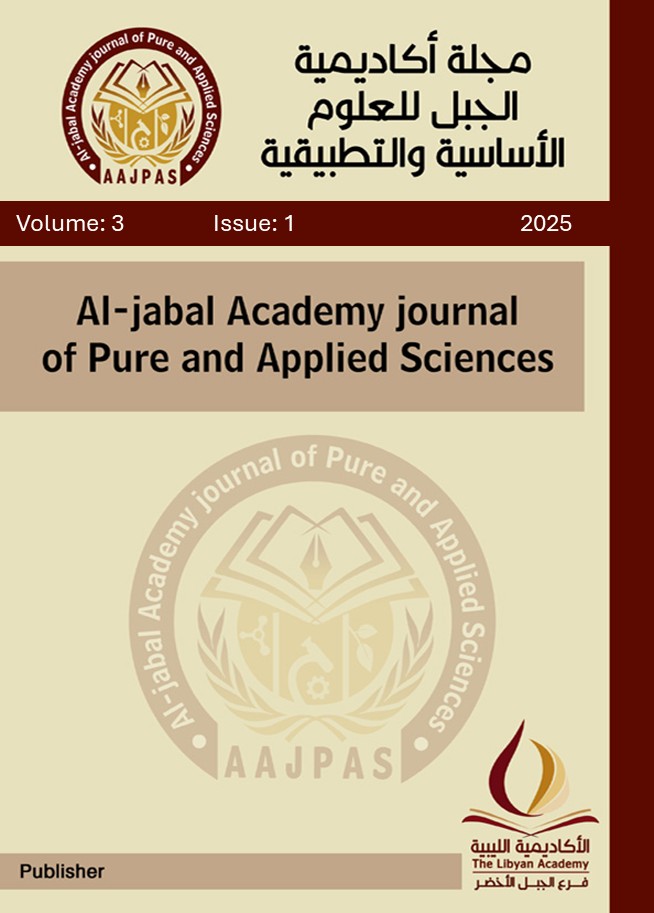Evaluation of the Solid Waste Landfill Management Process in Al- Bayda City and Studying Methods to Rehabilitation it and mitigate its Negative effects
DOI:
https://doi.org/10.58309/3hj8dg33Keywords:
landfill management , random landfill, landfill evaluation , rehabilitation , Al-Bayda city landfillAbstract
The city of Al-Bayda in the Libyan state suffers from the problem of the lack of a safe sanitary landfill for disposing of solid waste, as the current landfill is considered an open landfill that does not comply with environmental specifications and standards, and since the city has witnessed remarkable population and urban growth and the resulting increase in the production of waste that is Dispose of in landfill, the environmental and health risks that accompany it require taking the necessary measures to address this problem and preparing a study to evaluate the process of managing and operating this dump, determine the extent of its suitability, and work to mitigate the environmental impacts resulting from it by rehabilitating it, this is a process that must be carried out according to a specific methodology to help develop the most appropriate options and solutions, technology to reduce its environmental impacts to the maximum extent for this purpose, one of the internationally approved approaches used by the United Nations Environment Program (UNEP) was used to evaluate the risks resulting from waste dumps in developing countries and support the decision to determine the most appropriate options for conducting treatment and rehabilitation, based on the level of risks resulting from the landfill. this tool is known as (INTEGRATED RISK BASED APPROACH), (IRBA) which is a decision- making tool to determine the possibility of rehabilitating and reclaiming waste landfills, in which a group of characteristics is measured so that each characteristic has its own specific weight based on the strength of its impact and the degree of risk it poses, and the total weights distributed are On 27 properties It is 1000, and based on the measurements made for each characteristic, its intensity on the sensitivity index is determined, which ranges between (0 - 1), so that zero represents the lack of intensity of the effect or the absence of the characteristic measured on the sensitivity index, while the correct one represents the maximum intensity on the sensitivity scale, For 27 properties, the final value is The cumulative sum of the results of multiplying the weight of the characteristic by the amount of sensitivity to all studied variables. Based on this sum, the obtained result is evaluated to determine the level of risk resulting from the landfill and suggest the appropriate recommended procedure, through which it became clear that the total sum of the risk index of the (IRBA) methodology in a city landfill the Al-Bayda one was An amount of (602.32) and this value, according to the risk assessment criteria for landfills, indicates the possibility of a high risk and the need to close the landfill even though there are no more landfills in the area. According to the guide issued by the National Solid Waste Management Committee of the Japan International Cooperation Agency regarding the lock Safe waste disposal sites, the rehabilitation and safe closure processes that are compatible with the Al Bayda City landfill include stabilizing critical slopes and slopes, erecting retaining barriers, implementing a final cover for the landfill’s surface, implementing rainwater drainage facilities, gas disposal wells, a leachate collection pond, and constructing a fence around the landfill’s perimeter, And warning signs there is a guard gate at the main entrance.
Downloads
Published
Issue
Section
License
Copyright (c) 2025 Gasem A. B. Mohamed

This work is licensed under a Creative Commons Attribution-NonCommercial 4.0 International License.
Articles Copyright Published by Al-Jabal Academy Journal of Pure and Applied Sciences (AAJPAS) is retained to the author(s), who grant AAJPAS a license to publish the article. Also they accept the article remains published by AAJPAS website (except in occasion of a retraction of the article).







